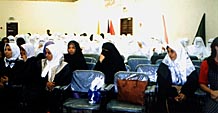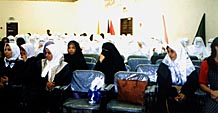
A New Group of Midwives Graduated in Dhamar [Archives:1999/25/Reportage]
June 21 1999

First of all, Mr. Charles Swagman, Team Leader, told the Yemen Times that “Dhamar’s Health Services projects were run by the Netherlands government, when we started the project there were no female workers and there were only three or four purposely built health centers. Hospitals were also not enough, the role of the primary health care was to get people involved. This was one of the key components, that people should contribute whatever they could for building a system, in addition to the finances. In 1985 we decided to shift our plan, i.e. instead of making one integrated project, the project was divided into two, a hospital project and Dhamar rural health care project. The hospitals further developed and were very successful. Later on we started the rural health care project. We started our project by getting some of the women from the community to be trained, not in their home villages, but in some of the selected sites. We started by training primary health care workers. There were training camps held in the country and the infrastructure was also built up, since there was no health office in Dhamar. We built a health office, held workshops and developed quite a lot of infrastructure by the time we were done. We had to face many obstacles after the war, because many personnel were changed, so in 1995 I found that the project was facing closure. I was given a tough assignment to make the project work. It was very fortunate for me to inherit a new team. We, along with the Head Office of Dhamar, re-established the cooperation. Our focus was on training and we exceeded in achieving our training goals by over 500%.””A ground work was made for cost sharing, in this new idea of community involvement, people have to pay for the health care in the countryside. We also worked a lot on such institutions, and worked very closely trying with the Minister of Health to see what could be done in this field to implement cost recovery. We have focused on institutional strengthening, and trying to make people more professional in their jobs. For example, we allocated the staff with additional database information system and worked for implementing continuous education program so that people could be trained and update their knowledge. An investment was made for building 11, new primary health care units,
and a whole rural health system. So today we can indeed declare a small, but a significant victory in the fight for health in Dhamar.
Mr. Adel Barakat, Public Health Advisor of Ether Vision and who is running the third phase of the Dutch supporting project for Dhamar services, talking about the third phase of the project, said:” Now, we are in the third phase which will be ending by June 30 1999. During this project our main concerns were to concentrate on the delivery of the mother and child health services everywhere, specially in those places where we didn’t previously delivered this kind of service before. Our main goals were to get female candidates from those areas and train them so that when they go back home, they can help their own village’s people.”
Asked about the reason behind focussing their attention on the female cadre rather than the male, Mr. Barakat said:
“From our previous experiences with the Ministry of Health and different agencies in the country I found the female cadre doesn’t have any tendency to start their own private business after being trained, and it’s easier to control and guide females as well. They are more preferred by other female patients. It was found that to achieve a successful program we should concentrate on females more, where in earlier days it was very difficult to find a female cadre. Nowadays, it’s easy to get literate females with a basic secondary qualification in rural areas according to the Ministry of Health requirement. Our plans that have been contracted with the organization were to train about 48 health care workers (Murshidat) in a period of four years i.e. 12 candidates of Murshidat to be trained every year. This number was really very small, compared to the very high demand. At that time our team leader supported us in training three groups of Murshidat. This made our candidates increase to 48 every year.
“The government found that a period of 12 months training was not sufficient. So, instead of graduating Murshidat they planned to extend the graduation period and go for community midwives. Plans were made for commencing this kind of training and there were two courses for preparing midwives which were going to be implemented in the areas who really needed this kind of service. Al-Hada is a good example for that. The major success that we have achieved in Al-Hada was in employing 80% of the females from Al-Hada itself, who helped in the deliveries of their own people. Well, there were great needs for relying on the Dhamari midwives, where previously the midwives used to come from Sudan. But, today we have around 48-52 Dhamari midwives serving in the field.””Recently, we established the Labor Practical Unit in Dhamar hospital, which is functioning with the help of Dhamari staff. Previously there weren’t any night duties, but with the establishment of this Unit we are working 24 hours with the participation of many female nurses who serve in these night duties.
Our final attempt is to establish a library which will contain many translated materials to support these people after graduation. I hope that we can succeed in fulfilling this intention soon.
By: Yusuf Sharif
Yemen Times
——
[archive-e:25-v:1999-y:1999-d:1999-06-21-p:./1999/iss25/report.htm]


